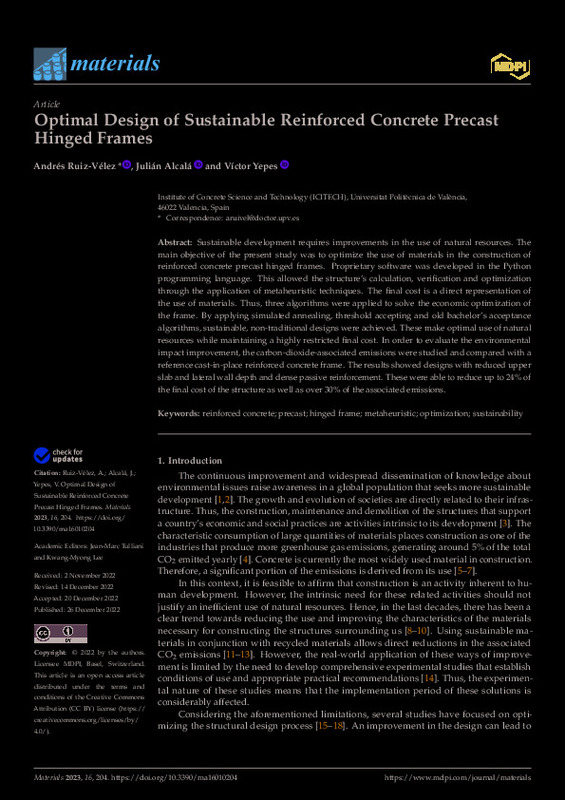JavaScript is disabled for your browser. Some features of this site may not work without it.
Buscar en RiuNet
Listar
Mi cuenta
Estadísticas
Ayuda RiuNet
Admin. UPV
Optimal Design of Sustainable Reinforced Concrete Precast Hinged Frames
Mostrar el registro sencillo del ítem
Ficheros en el ítem
| dc.contributor.author | Ruiz-Vélez, Andrés
|
es_ES |
| dc.contributor.author | Alcalá-González, Julián
|
es_ES |
| dc.contributor.author | Yepes, V.
|
es_ES |
| dc.date.accessioned | 2023-01-10T19:00:25Z | |
| dc.date.available | 2023-01-10T19:00:25Z | |
| dc.date.issued | 2022-12-20 | es_ES |
| dc.identifier.uri | http://hdl.handle.net/10251/191206 | |
| dc.description.abstract | [EN] Sustainable development requires improvements in the use of natural resources. The main objective of the present study was to optimize the use of materials in the construction of reinforced concrete precast hinged frames. Proprietary software was developed in the Python programming language. This allowed the structure¿s calculation, verification and optimization through the application of metaheuristic techniques. The final cost is a direct representation of the use of materials. Thus, three algorithms were applied to solve the economic optimization of the frame. By applying simulated annealing, threshold accepting and old bachelor¿s acceptance algorithms, sustainable, non-traditional designs were achieved. These make optimal use of natural resources while maintaining a highly restricted final cost. In order to evaluate the environmental impact improvement, the carbon-dioxide-associated emissions were studied and compared with a reference cast-in-place reinforced concrete frame. The results showed designs with reduced upper slab and lateral wall depth and dense passive reinforcement. These were able to reduce up to 24% of the final cost of the structure as well as over 30% of the associated emissions. | es_ES |
| dc.description.sponsorship | The authors acknowledge the financial support of Grant PID2020-117056RB-I00 funded by MCIN/AEI/10.13039/501100011033 and by "ERDF A way of making Europe" | es_ES |
| dc.language | Inglés | es_ES |
| dc.publisher | MDPI AG | es_ES |
| dc.relation.ispartof | Materials | es_ES |
| dc.rights | Reconocimiento (by) | es_ES |
| dc.subject | Reinforced concrete | es_ES |
| dc.subject | Precast | es_ES |
| dc.subject | Hinged frame | es_ES |
| dc.subject | Metaheuristic | es_ES |
| dc.subject | Optimization | es_ES |
| dc.subject | Sustainability | es_ES |
| dc.subject.classification | INGENIERIA DE LA CONSTRUCCION | es_ES |
| dc.title | Optimal Design of Sustainable Reinforced Concrete Precast Hinged Frames | es_ES |
| dc.type | Artículo | es_ES |
| dc.identifier.doi | 10.3390/ma16010204 | es_ES |
| dc.relation.projectID | info:eu-repo/grantAgreement/AEI/Plan Estatal de Investigación Científica y Técnica y de Innovación 2017-2020/PID2020-117056RB-I00/ES/OPTIMIZACION HIBRIDA DEL CICLO DE VIDA DE PUENTES Y ESTRUCTURAS MIXTAS Y MODULARES DE ALTA EFICIENCIA SOCIAL Y MEDIOAMBIENTAL BAJO PRESUPUESTOS RESTRICTIVOS/ | es_ES |
| dc.rights.accessRights | Abierto | es_ES |
| dc.contributor.affiliation | Universitat Politècnica de València. Escuela Técnica Superior de Ingenieros de Caminos, Canales y Puertos - Escola Tècnica Superior d'Enginyers de Camins, Canals i Ports | es_ES |
| dc.description.bibliographicCitation | Ruiz-Vélez, A.; Alcalá-González, J.; Yepes, V. (2022). Optimal Design of Sustainable Reinforced Concrete Precast Hinged Frames. Materials. 16(1):1-23. https://doi.org/10.3390/ma16010204 | es_ES |
| dc.description.accrualMethod | S | es_ES |
| dc.relation.publisherversion | https://doi.org/10.3390/ma16010204 | es_ES |
| dc.description.upvformatpinicio | 1 | es_ES |
| dc.description.upvformatpfin | 23 | es_ES |
| dc.type.version | info:eu-repo/semantics/publishedVersion | es_ES |
| dc.description.volume | 16 | es_ES |
| dc.description.issue | 1 | es_ES |
| dc.identifier.eissn | 1996-1944 | es_ES |
| dc.identifier.pmid | 36614541 | es_ES |
| dc.relation.pasarela | S\479757 | es_ES |
| dc.contributor.funder | AGENCIA ESTATAL DE INVESTIGACION | es_ES |
| dc.subject.ods | 09.- Desarrollar infraestructuras resilientes, promover la industrialización inclusiva y sostenible, y fomentar la innovación | es_ES |








